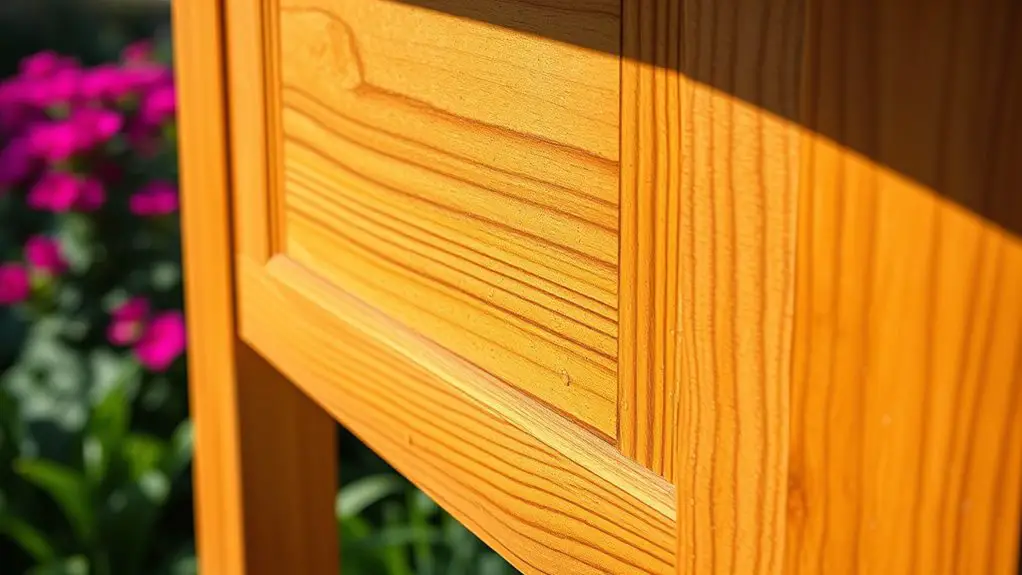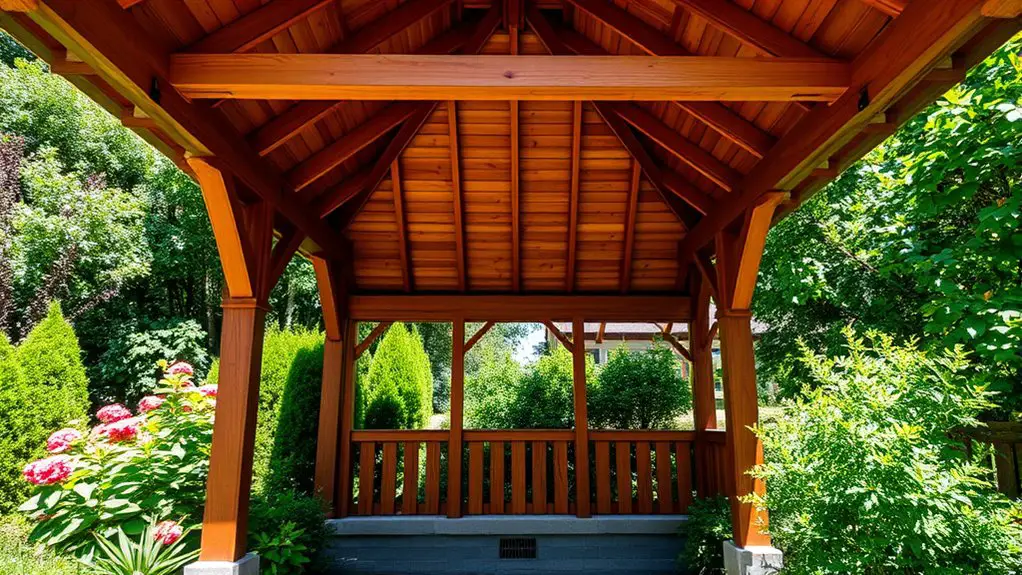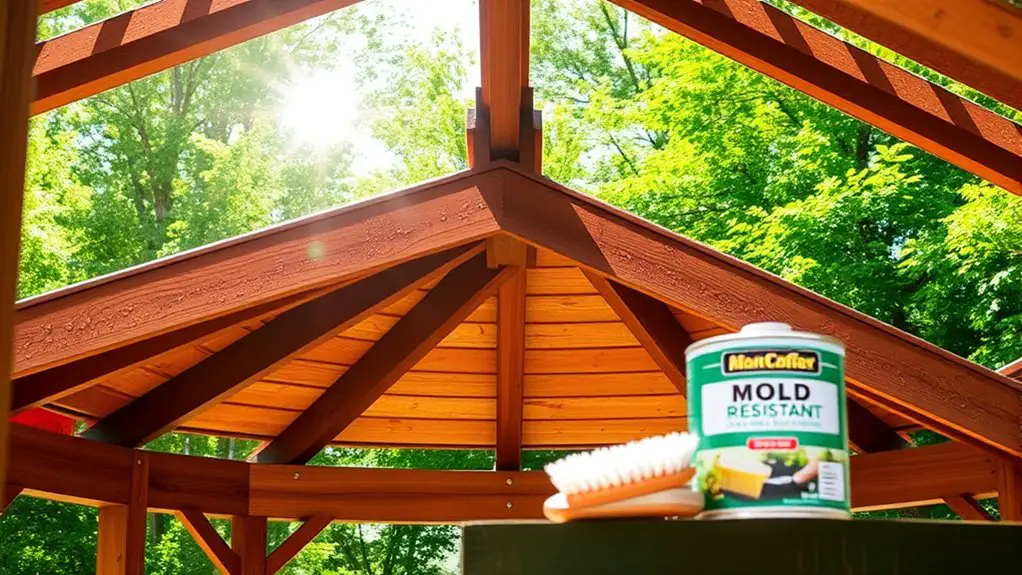To prevent mold and mildew on your gazebo wood, start by choosing pressure-treated wood or durable hardwoods like cedar and redwood. Apply a quality sealant designed for your wood type that repels water and mold. Make certain your gazebo has good drainage and airflow by positioning it away from water pools and keeping it elevated. Regularly clean surfaces and inspect for moisture. Using mold-resistant products can also enhance protection. There’s more you can do to maintain your gazebo effectively.
Choose the Right Wood for Your Gazebo

When building a gazebo, selecting the right wood is essential for preventing mold and mildew. You’ll want to evaluate pressure treated wood, as it’s been chemically treated to resist moisture and decay, making it a practical choice for outdoor structures. This type of wood can withstand the elements better than untreated options, reducing the risk of mold growth.
If you’re looking for something more aesthetically appealing, hardwood options like cedar or redwood are excellent alternatives. These woods are naturally resistant to moisture and insects, providing an added layer of protection. While hardwoods might come at a higher cost, their durability and beauty can make your gazebo a stunning focal point in your yard.
Ultimately, choosing the right wood is about balancing functionality and aesthetics to create a space where you can enjoy freedom outdoors without worrying about mold and mildew. Additionally, considering the durability of steel frames can enhance the overall resilience of your gazebo structure against environmental factors.
Apply a Quality Sealant
To keep mold and mildew at bay, applying a quality sealant to your gazebo wood is crucial. Start by choosing the right sealant types that suit your wood species and environment. Look for water-repellent sealants or those with mold inhibitors for the best protection.
Before application, verify the wood is clean and dry to maximize adhesion. Use a brush or roller for even coverage, applying the sealant in thin, consistent layers. Make certain to follow the manufacturer’s instructions regarding drying times and the number of coats needed.
Don’t forget to address hard-to-reach areas, as they can be hotspots for mold growth. Regularly inspect your gazebo and reapply the sealant as necessary, usually every one to three years, depending on your climate. Additionally, regular cleaning of the gazebo fabric and surroundings will help minimize the risk of mold development. By taking these steps, you’ll help maintain the beauty and integrity of your gazebo while enjoying the freedom of outdoor living.
Maintain Proper Drainage and Airflow

Applying a quality sealant is just one part of protecting your gazebo wood from mold and mildew. To truly safeguard your structure, you need to focus on maintaining proper drainage and airflow. Start by ensuring effective drainage systems are in place. This means positioning your gazebo away from areas where water tends to pool and checking that gutters and downspouts direct water far from the wood.
Next, prioritize airflow management. Good airflow prevents moisture buildup, which is a breeding ground for mold. You can achieve this by placing your gazebo in an open area, allowing wind to circulate freely. Additionally, consider elevating the gazebo slightly off the ground to enhance airflow underneath. Implementing effective gutter systems can also play a crucial role in directing water away from the gazebo and reducing the risk of moisture-related issues.
Regular Cleaning and Inspection
Regular cleaning and inspection are essential practices for keeping your gazebo wood free from mold and mildew. By incorporating routine maintenance into your schedule, you can spot potential problems early and preserve your outdoor space. Here’s a quick inspection checklist to follow:
Regular maintenance is key to protecting your gazebo wood from mold and mildew, ensuring a beautiful outdoor space.
- Inspect for Dampness: Check for any areas that retain moisture, especially after rain.
- Clean Surfaces: Use a mild detergent and water to wipe down surfaces, removing dirt and debris.
- Look for Signs of Growth: Regularly examine wood for discoloration or fuzzy patches, indicating mold or mildew.
- Check Seals and Joints: Verify all joints and seals are intact to prevent water intrusion. Regular inspections can help you preventative measures from becoming necessary before mold takes hold.
Utilize Mold-Resistant Products

Mold-resistant products can be a game-changer for protecting your gazebo wood from unwanted growth. By using mold inhibitors, you can prevent spores from taking hold and spreading. Look for wood treatments specifically designed to repel mold and mildew, which can be applied during installation or maintenance.
Additionally, applying protective coatings is essential. These coatings not only provide a barrier against moisture but also enhance the wood’s appearance. Choose a high-quality sealant or stain that contains mold-resistant properties. Regularly check the effectiveness of these products and reapply as necessary, especially after harsh weather conditions. This proactive approach keeps your gazebo looking great and extends its lifespan. With the right mold-resistant solutions, you can enjoy your outdoor space without the worry of mold and mildew ruining your relaxation time. Embrace freedom in your outdoor living by ensuring your gazebo remains a beautiful, healthy haven.
Moreover, consider using mold-resistant wood treatments that enhance the durability of your gazebo against weathering and decay.
Frequently Asked Questions
What Are the Signs of Mold Growth on Gazebo Wood?
You’ll notice dark spots, a musty odor, or discoloration when evaluating your gazebo. Use mold identification techniques and apply regular gazebo maintenance tips to keep your space inviting and free from unwanted growth.
Can I Use Bleach to Clean Mold off Wood?
While bleach can seem like a knight’s armor against mold, it can damage wood fibers. For effective mold removal and proper wood care, consider using a mixture of vinegar or specialized wood cleaners instead.
How Often Should I Inspect My Gazebo for Mold?
You should inspect your gazebo at least twice a year for mold detection. An inspection schedule helps you catch issues early, ensuring your space remains enjoyable and safe while preserving its beauty and structural integrity.
Is Pressure Washing Safe for Gazebo Wood?
Just like a gentle rain refreshes a garden, pressure washing can rejuvenate your gazebo’s wood. However, too much force can damage it. For effective wood maintenance, use a low-pressure setting to avoid harm.
What Natural Remedies Can I Use to Prevent Mold?
To prevent mold, you can use natural cleaners like vinegar or baking soda. Adding essential oils such as tea tree or lavender not only helps deter mold but also leaves a pleasant scent, enhancing your space.

